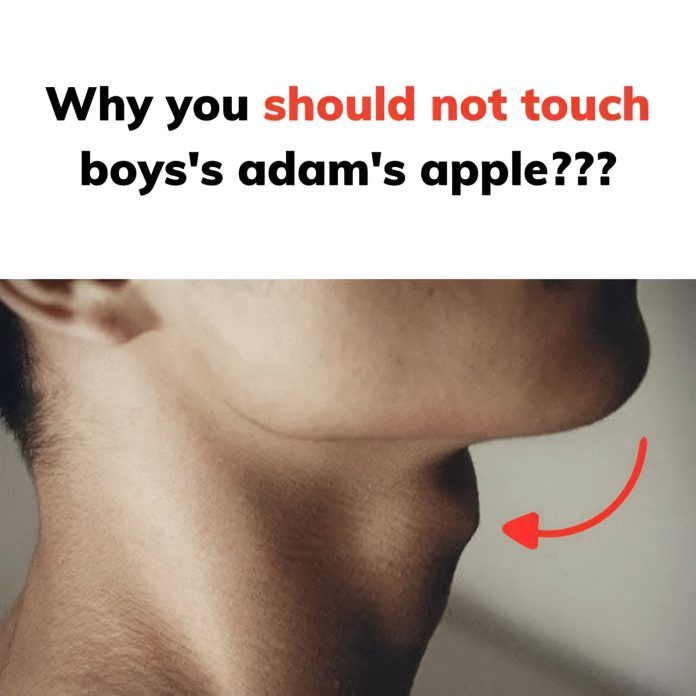The Adam’s apple is a distinctive feature found in the front of the throat, more formally known as the thyroid cartilage. It is part of the laryngeal structure and becomes more prominent during puberty, especially in men. Despite its noticeable appearance, the Adam’s apple does not serve a significant function beyond protecting the vocal cords. While many people associate it with masculinity, there are several misconceptions and lesser-known facts about this cartilage structure.
The Name Has No Biblical Origins
Many people believe that the term “Adam’s apple” originates from the biblical story of Adam and Eve. According to this myth, Adam ate the forbidden fruit in the Garden of Eden, and a piece of it got stuck in his throat as a permanent reminder of his sin. While this tale seems logical, historical evidence suggests otherwise.
The actual origin of the name is linked to medieval Arabic medical texts. During the Middle Ages, Arabic scholars referred to the throat cartilage as “pomegranate,” a term that later influenced European languages. Since the Latin words for “apple” and “pomegranate” are quite similar, the translation into English led to the now-familiar term “Adam’s apple.”

Why You Should Avoid Touching a Man’s Adam’s Apple
The Adam’s apple is a particularly sensitive part of the throat, which is why touching it can cause discomfort. This structure is formed by the thyroid cartilage, which surrounds the larynx (voice box) and is closely connected to the vocal cords. Due to its delicate positioning, even a light touch can trigger an uncomfortable sensation, and excessive pressure may even cause pain.
For many people, having their Adam’s apple touched feels intrusive or even ticklish. In extreme cases, pressing on the area can interfere with breathing and speech. Respecting personal boundaries is important, especially when it comes to sensitive parts of the body like the throat.
Women Also Have an Adam’s Apple
While the Adam’s apple is commonly associated with men, it is not an exclusively male trait. Both men and women have an Adam’s apple because it is simply cartilage surrounding the larynx. However, men’s Adam’s apples tend to be larger and more prominent due to hormonal changes during puberty.
During adolescence, increased levels of testosterone cause the larynx to grow, deepening the voice and making the cartilage more noticeable. In contrast, women’s larynxes grow less, so their Adam’s apple usually remains small and less visible. That being said, some women do have visible Adam’s apples, especially if they have lower body fat or a naturally larger laryngeal structure.
When Adam’s Apple Pain May Indicate a Health Problem
Although the Adam’s apple itself does not cause pain, discomfort in the surrounding area may signal an underlying health issue. Some conditions that could contribute to throat pain near the Adam’s apple include:
1. Laryngeal Cancer
Persistent throat pain or soreness
Difficulty swallowing
Hoarseness or changes in voice
A lingering cough
Bad breath
Breathing difficulties
Laryngeal cancer affects the voice box (larynx) and can cause symptoms that worsen over time. While sore throats are common and often harmless, persistent discomfort, especially when swallowing, should not be ignored.
2. Thyroid Cancer
A lump or swelling in the throat
Hoarseness lasting longer than a few weeks
Pain near the thyroid gland
Swollen lymph nodes
Unexplained weight loss
Since the thyroid gland is located near the Adam’s apple, thyroid-related conditions may cause pain or pressure in that area. If you notice prolonged discomfort along with other symptoms, seeking medical advice is crucial.
3. Common Conditions Like Acid Reflux or Infections
Not all throat pain is caused by severe diseases. Some less serious conditions that may cause discomfort around the Adam’s apple include:
- Acid reflux (GERD): Stomach acid backing up into the throat can cause irritation and pain near the Adam’s apple.
- Viral or bacterial infections: Sore throat from colds, flu, or strep throat may temporarily cause discomfort in the neck and throat area.
- Muscle strain: Overuse of vocal cords (such as excessive talking or shouting) can lead to soreness in the throat.
If the pain is mild and short-lived, it is likely due to a temporary issue. However, if symptoms persist, worsen, or are accompanied by other concerning signs, visiting a doctor is advisable.

Final Thoughts
The Adam’s apple is a unique part of human anatomy, but it is often misunderstood. While its name has nothing to do with the biblical story of Adam and Eve, the term has historical roots in ancient medical texts. Contrary to popular belief, women also have an Adam’s apple, though it is typically smaller and less prominent than men’s.
Since the Adam’s apple is a sensitive area, it is best to avoid touching it unnecessarily to prevent discomfort. Additionally, persistent pain in this region may be a sign of a more serious health condition, such as thyroid disorders or laryngeal cancer. While occasional throat soreness is normal, it is always wise to consult a medical professional if symptoms are prolonged or severe.
Understanding the true nature of the Adam’s apple can help dispel common myths and encourage better awareness of throat health.

















